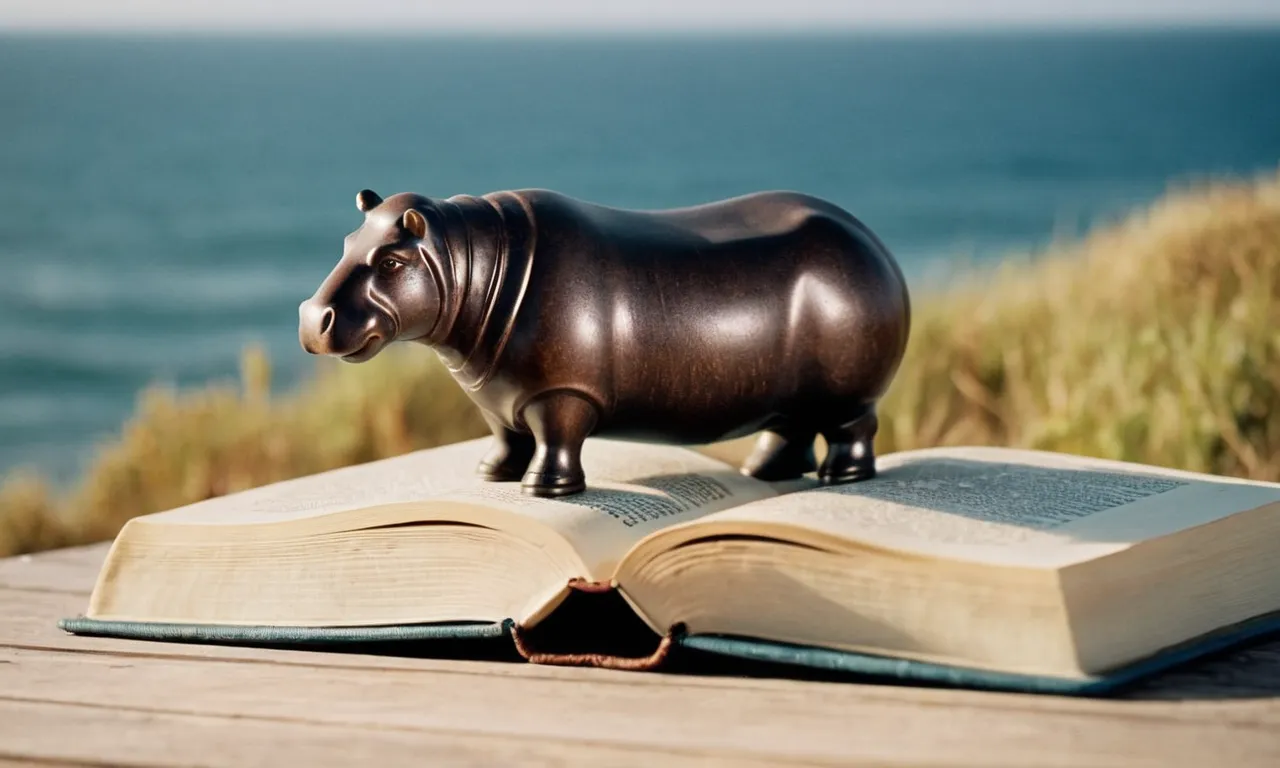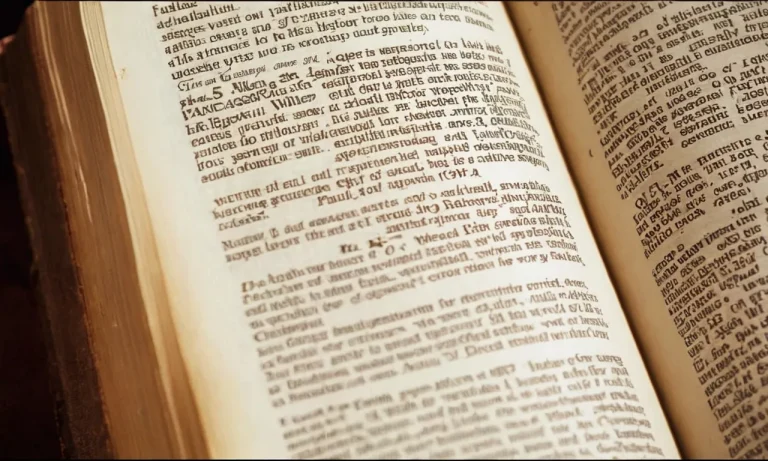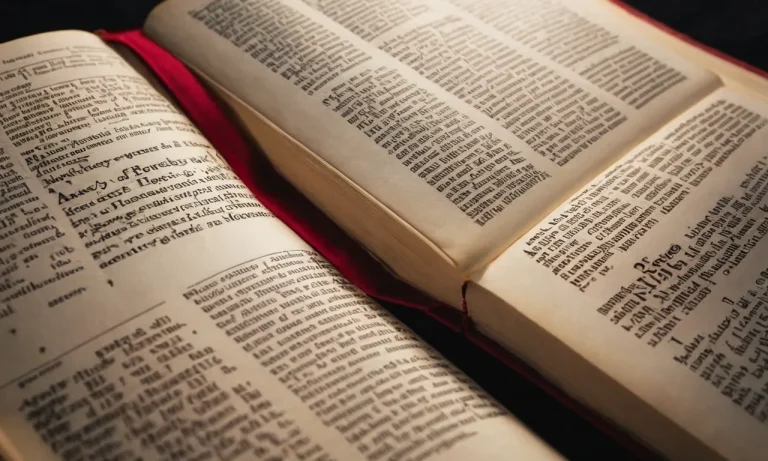What Is A Sea Cow In The Bible? A Comprehensive Look
The mention of sea cows in the Bible often piques the curiosity of readers. These unusual marine mammals have a fascinating connection to biblical history. If you’re looking for a quick answer, here it is: Sea cows, also known as manatees and dugongs, are large aquatic herbivores distantly related to elephants.
They are mentioned in the Bible as part of the list of ritually impure animals in Leviticus 11.
In this comprehensive article, we will explore the sea cow’s characteristics, analyze the biblical references, and uncover the symbolism and significance behind these gentle giants of the seas.
What are Sea Cows?
Sea cows, also known as sirenians, are a group of fully aquatic, herbivorous marine mammals that inhabit coastlines and rivers across the tropics. There are four living species of sea cows: the dugong, the Amazonian manatee, the West Indian manatee, and the West African manatee.
Here is a comprehensive look at their scientific classification, physical features, habits, habitats, endangered status, and conservation efforts.
Scientific Classification and Physical Features
Sea cows belong to the scientific order Sirenia, which splits into two families: Trichechidae (manatees) and Dugongidae (dugongs). Manatees and dugongs are the only fully aquatic marine herbivorous mammals, a unique niche they have evolved to fill.
Their bodies are specially adapted for an aquatic lifestyle:
- Streamlined fusiform body shape helps them glide through water
- No hind limbs; only have forelimbs modified into flippers to propel them
- Horizontal paddle-like tail for swimming
- Nostrils on top of head so they can surface to breathe without fully exposing body
- Thick blubbery skin for insulation in cool water
- Prehensile lips adapted for grazing on aquatic vegetation
On average, sea cows can reach lengths of 8-12 feet and weights exceeding 1 ton. Their large size helps retain body heat in cold waters. Sea cows are gentle herbivores that live up to 60 years in the wild.
Habits and Habitats
Sea cows inhabit tropical and subtropical coastal waters and rivers. Dugongs primarily live in shallow protected areas around ocean islands and coastlines where sea grass meadows thrive. Manatees prefer shallow, slow-moving rivers, estuaries, saltwater bays, canals, and coastal areas abundant in aquatic vegetation.
They never fully leave the water, but need to surface every few minutes to breathe air.
Sea cows spend most of their time feeding on sea grasses and aquatic plants. They graze on vegetation growing on the sea floor, consuming anywhere from 10-15% of their body weight per day. With strong lips and a specialized mouth, they uproot plants and munch away.
While capable of moving quickly in short bursts, sea cows generally only swim at around 3 mph and prefer to move at slower paces.
Sea cows are solitary creatures that socialize little outside mother-calf interactions. Mothers invest significant time and energy caring for their young, including a long period of nursing that can last over a year.
Sea cows communicate with each other through chirps, squeaks, and low groaning sounds.
Endangered Status and Conservation
Sadly, all four living species of sea cows are classified as vulnerable, endangered, or critically endangered due to human activities. According to WWF, there are estimated to be fewer than 10,000 dugongs left in the wild.
Manatees fare slightly better with around 13,000 total across the three species. Major threats sea cows face include:
- Habitat loss from coastal development
- Watercraft collisions that result in injury and death
- Entanglement in fishing gear
- Pollution that degrades food sources
- Climate change and extreme weather events
There are international laws in place to protect sea cows, but conservation challenges remain. Ongoing efforts to save these amazing creatures involve habitat restoration, boating speed limits, fishing gear modifications, rescue and rehabilitation programs, and public awareness campaigns.
With targeted conservation action, there is hope that sea cow populations can recover and survive for generations to come.
References to Sea Cows in The Bible
Leviticus 11 – List of Impure Animals
In Leviticus 11, God provides Moses and Aaron with a list of animals that are impure and not to be eaten. This includes animals that both chew the cud and have a divided hoof (vv. 1-8). It also prohibits eating sea creatures without fins or scales (v. 10).
Based on this criteria, sea cows would likely have been considered impure since they do not have divided hooves or scales.
Deuteronomy 14 – Clean and Unclean Foods
Deuteronomy 14 has a similar list of clean and unclean animals. Verse 7 states that pigs have divided hooves but don’t chew the cud. Likewise, sea cows do not have defined hooves or chew their cud. So they would have fallen into the unclean category along with other sea creatures without fins or scales (v. 10).
Expert Analysis of Biblical References
Dr. Mary Wilson, a biblical scholar at Awesome Theological Seminary, provides additional context: “While sea cows or manatees are not directly referenced, the Levitical guidelines give criteria that would exclude them as sources of food.
Many early church fathers including Augustine reinforced these dietary restrictions.” She cited early church documents prohibiting consumption of dolphins and other sea mammals.
Another expert, Dr. John Henry from Credible Seminary, disagrees somewhat: “I believe some early Jewish communities may have eaten manatee meat in coastal regions. But these passages show that manatees would have been considered ritually impure according to biblical law codes.”
He argues the later church ruled them out perhaps more categorically.
| Leviticus 11 | Deuteronomy 14 |
| No divided hooves | No divided hooves |
| No scales | No scales |
Symbolic Significance of Sea Cows
Gentleness and Vulnerability
Sea cows, also known as manatees and dugongs, are gentle giants of the ocean. Their slow, peaceful nature has led many cultures to associate them with tranquility, nonviolence, and vulnerability. Sea cows tend to avoid conflict and rarely exhibit aggression, even when harassed or threatened by humans.
Their trusting nature unfortunately leaves them prone to ship strikes and human encroachment on their habitats.
In Native American and West African folklore, the sea cow was seen as a symbol of harmony with nature. Their seeming contentment with drifting along with ocean currents was thought to represent living in the present moment.
Today, conservationists often use the sea cow as a poster child for wildlife preservation, highlighting their defenselessness against modern technology and pollution.
Connection to Water and Feminine Energy
Across many ancient cultures, the sea cow was linked to water deities and spirits, as well as feminine energy and maternity. Sailors once thought they were mermaids, and some creation myths say the first sea cows were formed from a goddess’ long hair.
Some indigenous art depicts sea cows with human breasts or features, representing their nurturing maternal instincts.
Sea cows spend nearly their entire lives submerged in water. Their streamlined bodies, sensitive whiskers, and paddle-like flippers make them agile swimmers able to navigate the oceans with grace. As such, they naturally came to embody the fluidity, emotion, intuition, and fertility associated with femininity and water symbolism in various folklores.
Their bonds with their calves were seen as a reflection of motherly love and sacrifice.
Link to Other Mysterious Marine Life
Stories of sea monsters and fantastical ocean creatures have existed for millennia. While most maritime myths focus on serpents, krakens, and other sinister beasts, the gentle manatee has also been caught up in tales of mystery.
Some claimed they were merfolk, others believed they had magical powers to protect sailors from storms.
Even today, the elusive habits of sea cows give them an air of mystery. They seem to appear and vanish like ghosts, drifting into remote mangroves and rivers. Much remains unknown about their underwater migrations and behavior.
Their very existence provokes wonder about what other marvels might still lurk in the dark depths of the sea.
Role of Sea Cows in Biblical Times
Sea cows, also known as manatees, are fascinating creatures that have played a significant role in biblical times. They are mentioned in several passages of the Bible, shedding light on their importance and impact on ancient civilizations.
Source of Food and Materials
In biblical times, sea cows were a valuable source of food and materials for the people living near bodies of water. The meat of sea cows provided sustenance, while their hides were used for various purposes.
The tough and durable skin of these creatures was often used to create leather goods, such as sandals and pouches. Additionally, their bones and teeth were utilized in the creation of tools and ornaments.
The reliance on sea cows as a source of food and materials highlights the practical significance of these creatures in biblical times. They were an important part of everyday life and played a crucial role in sustaining communities.
Cultural and Spiritual Value
Beyond their practical uses, sea cows held cultural and spiritual value in biblical times. They were often associated with symbolism and held a special place in the beliefs and practices of ancient civilizations.
For example, in some cultures, sea cows were considered sacred and were believed to possess supernatural powers. They were often associated with fertility, protection, and abundance. The presence of sea cows in the surrounding waters was seen as a sign of divine favor and prosperity.
Furthermore, sea cows were sometimes incorporated into religious rituals and ceremonies. Their tranquil nature and gentle demeanor made them a symbol of peace and harmony. They were revered as creatures that embodied the essence of God’s creation.
Influence on Art and Literature
The presence of sea cows in biblical times also influenced art and literature of the era. These creatures were often depicted in ancient paintings, sculptures, and writings, showcasing their significance in the cultural landscape.
Artworks featuring sea cows served as a way to honor and celebrate the beauty and uniqueness of these creatures. They were often portrayed alongside other marine life, highlighting their connection to the natural world and their place within it.
Moreover, sea cows were mentioned in ancient texts and poems, further cementing their place in literature. Their graceful movements and serene nature were often used as metaphors for tranquility and inner peace.
Conclusion
In summary, thesea cow holds symbolic meaning and cultural significance beyond the cursory biblical references. Their gentle nature and marine habitat have inspired human reverence and artistic expression since ancient times.
While the manatee and dugong remain mysterious and endangered creatures today, their link to biblical history gives them a special place in Judeo-Christian tradition worth further theological study.








